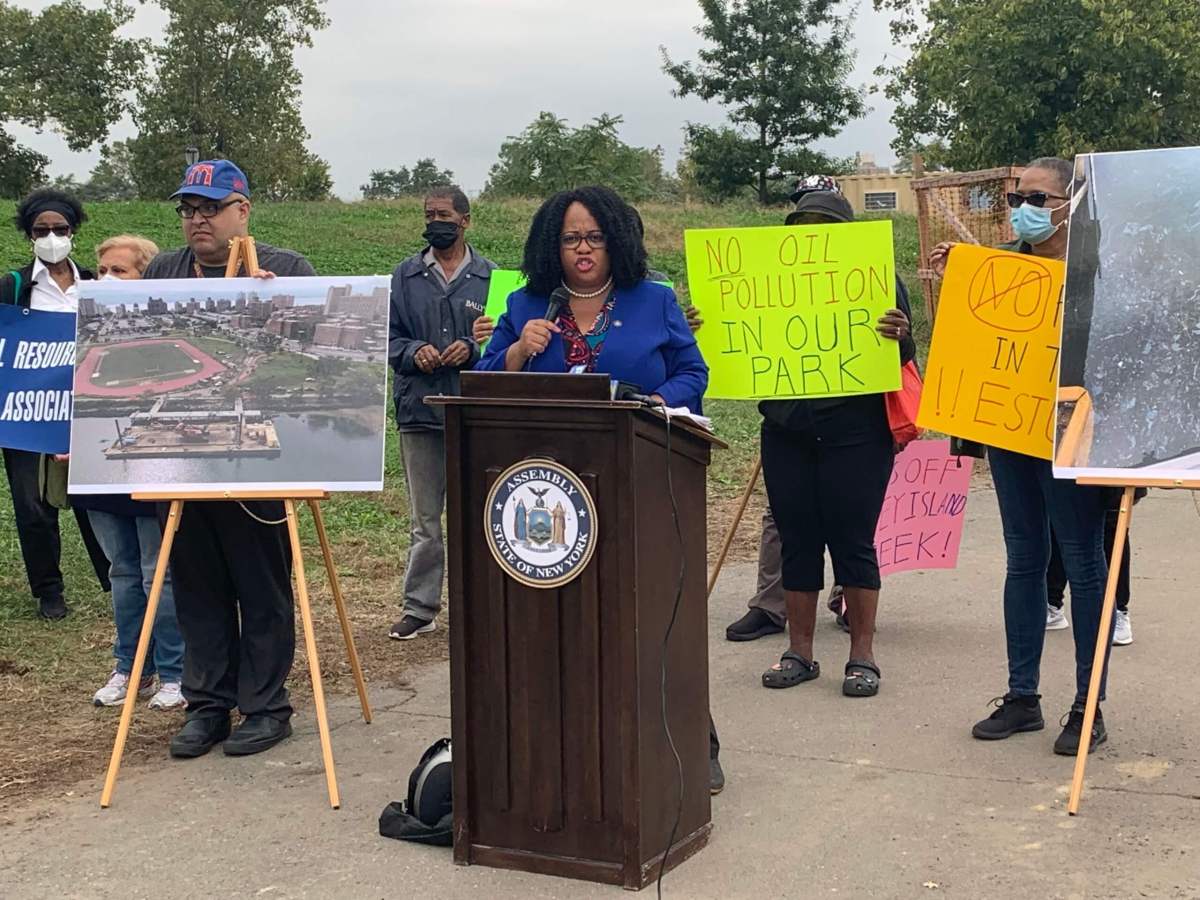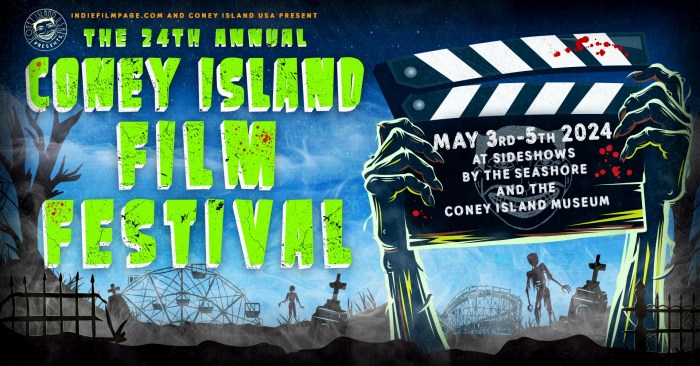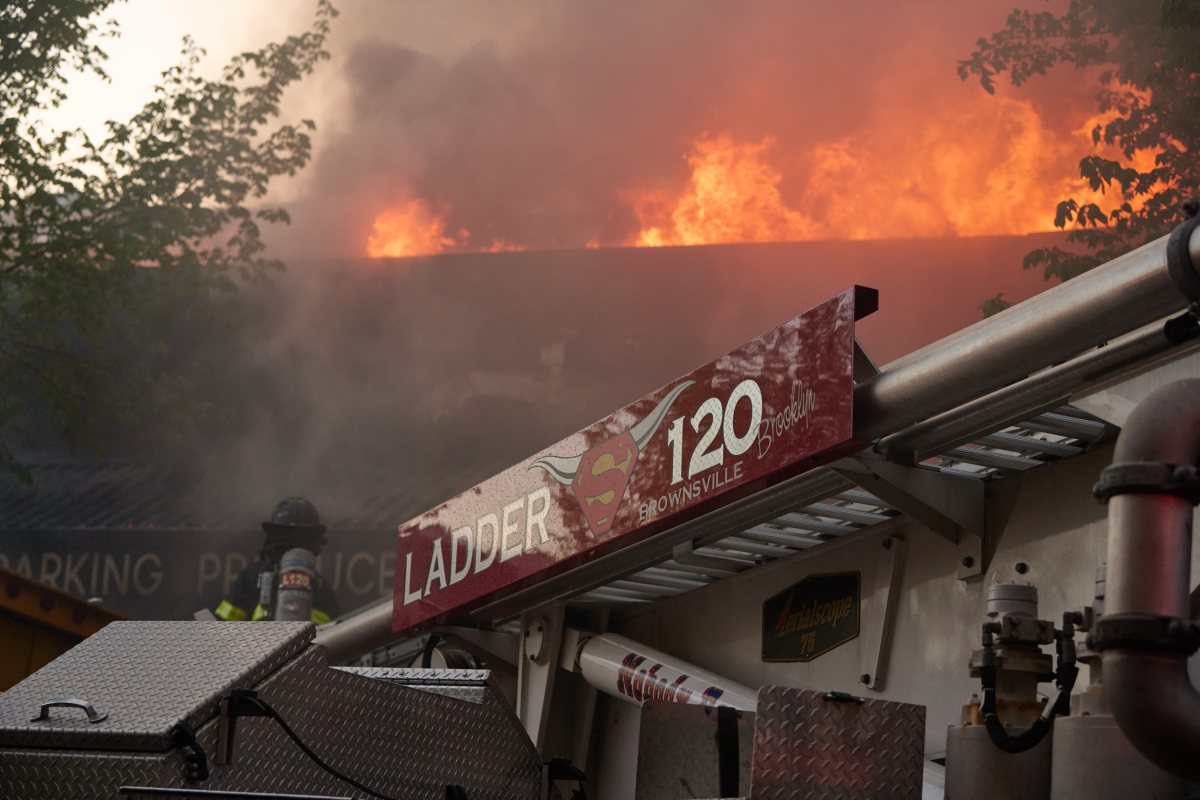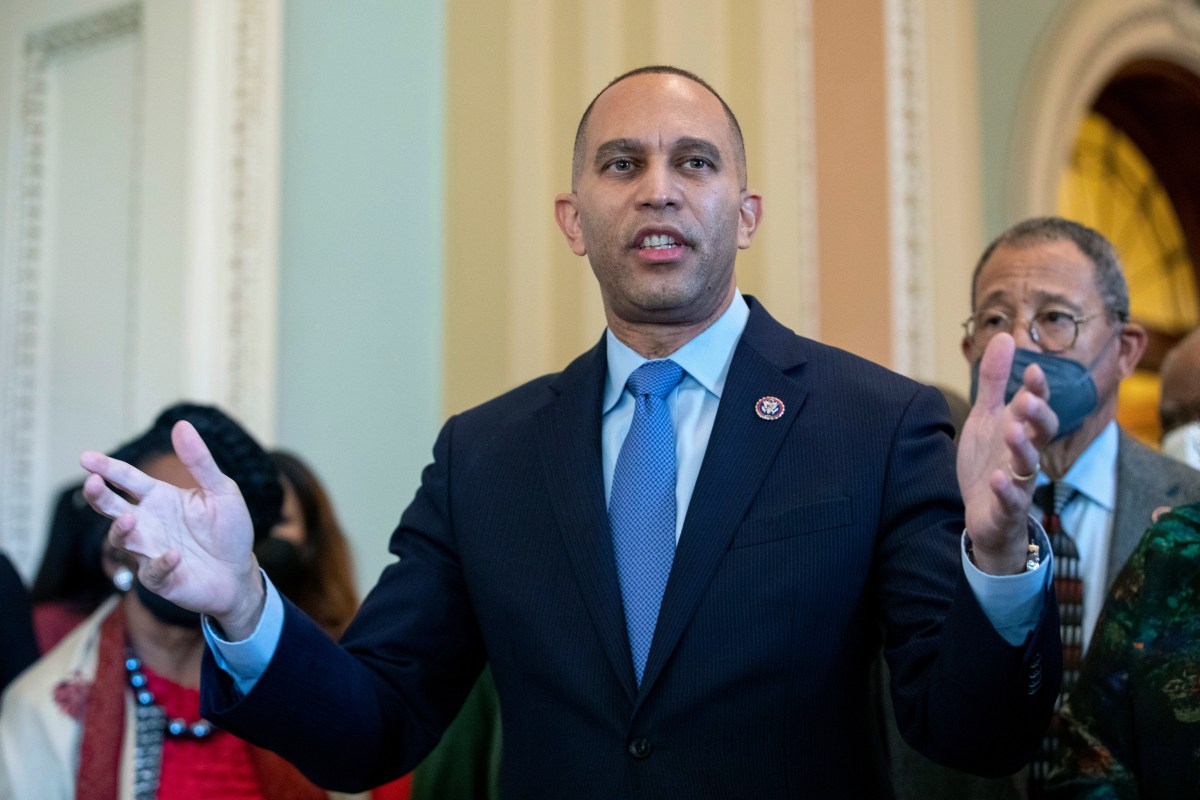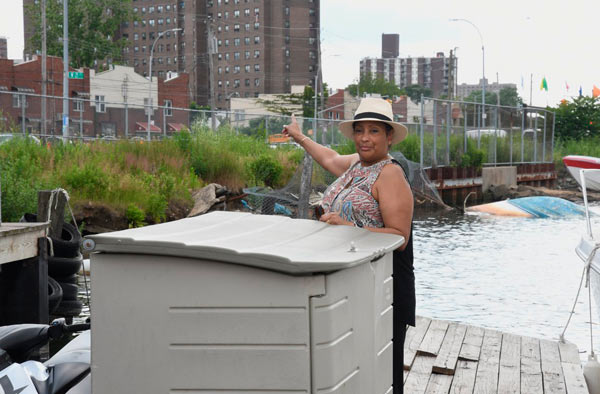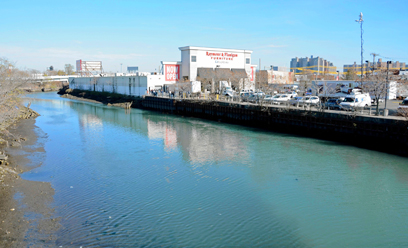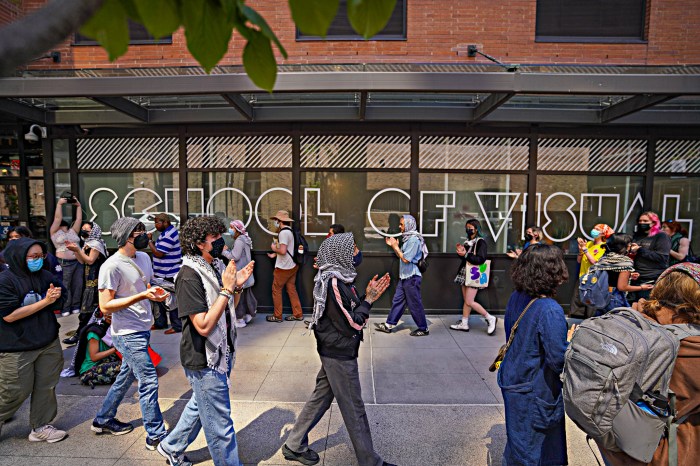After Coney Islanders believe they spotted an oil sheen on the waters of Coney Island Creek, local residents and elected officials are once again asking various government agencies to look into the safety of the peninsula’s incoming ferry landing now that dredging has begun.
“We are asking for a robust assessment from the city, the state and the federal government,” said Assemblymember Mathylde Frontus, who organized an Oct. 13 press conference on the gruesome discovery. “We want them to monitor the air quality here that we are breathing, we want them to test this water and we want to know what are the effects of the dredging.”
On Oct. 5, two separate Coney Island residents took photos of what they believed were oil slicks on the creek at Kaiser Park, where the city’s Economic Development Corporation (EDC) is building a new ferry landing. The next day, Frontus gave those photos to the New York State Department of Environmental Conservation (DEC), the Environmental Protection Agency (EPA), and the Coast Guard.
“We had someone out here with a drone…There were oil sheens right where the construction rig was,” Ida Sanoff, the executive director of the National Resources Protective Association and a Coney Island resident, told the community. “On that same morning, a scientist who runs local educational programs down here took those pictures in this immediate area where the work was being done, also showing an oil spill.”
Both DEC and the Coast Guard inspected the site on Oct. 6 and Oct. 7, but their contradicting responses have raised alarm bells in the community.
At the Oct. 13 presser, Frontus shared with the crowd a text message from a representative with the Coast Guard, who suspected the contamination was caused by dredging. Meanwhile, DEC has claimed otherwise, saying it could be from multiple sources.
“A team from the NY DEC attended the site, searched for pollution source, monitored the workers, and inspected the equipment,” the Coast Guard text message read. “We currently suspect that the pollution was released by disturbing contaminated sediment.”
DEC, though, said they could not immediately identify any petroleum in the creek or along its banks, according to an agency spokesperson, who said the alleged oil slicks could have resulted from multiple sources, other than the dredging activity — such as sewer discharges or residual petroleum from dumping upland long ago, which the agency is currently working to contain.
The agency does plan to monitor the ongoing dredging work to ensure the city’s Economic Development Corporation is complying fully with their state permit, and will help improve the project’s pollution controls during construction, the spokesperson said, adding that the agency will issue necessary enforcement to protect the environment and public health.
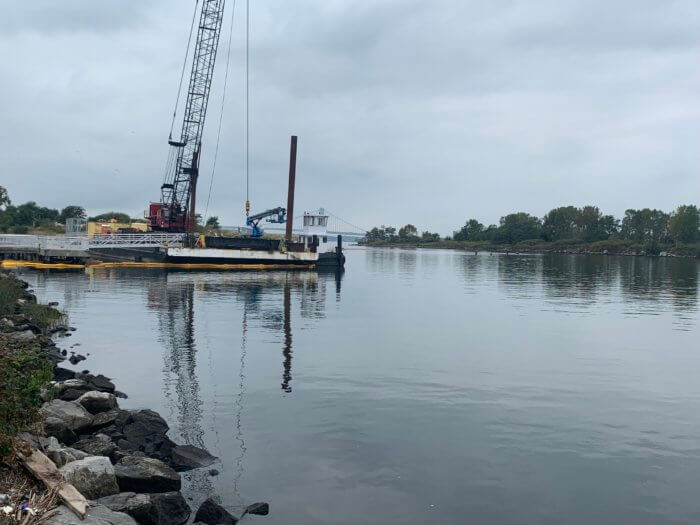
The regional press officer for the federal Environmental Protection Agency wrote in an email to Brooklyn Paper that they received notice of the suspected contamination on Oct. 7, but that the city’s EDC, the state’s Department of Environmental Conservation, and the Army Corps of Engineers are responsible for the dredging work, with the economic agency in charge of ensuring the construction meets the requirements of the Army Corps.
“The primary agencies responsible for permitting the ongoing dredging activities at Coney Island Creek are the New York City Economic Development Corporation, the New York State Department of Environmental Conservation, and the U.S. Army Corps of Engineers,” Stephen McBay wrote. “NYCEDC has the lead responsibility to ensure that the work complies with USACE permit requirements.”
But a representative from the Economic Development Corporation, the quasi-governmental organization focused on driving economic growth across the five boroughs, said in a statement that it has not seen proof of an oil slick which can’t be concluded until the state Department of Environmental Conservation completes their process of determination — that the ferry builders said only will further prove their work is not the cause.
“NYCEDC is proud and excited to bring ferry service to Coney Island residents after years of planning and community engagement. We have been notified that some residents have observed some debris in the historically polluted creek,” said an agency spokesperson. “Nothing has been observed connected to our activities, and we welcome monitoring by the New York State Department of Environmental Conservation to help us ensure our work has no negative environmental impact on the creek and residents. And we look forward to launching NYC Ferry very soon.”
Their plan to dredge underwent review and was approved by the state Department of Environmental Conservation and the Army Corps of Engineers where no concerns were raised on its possible impact on the creek’s ecosystem, the press rep stated.
“Our dredging plan was reviewed and permitted by the regulatory agencies DEC and USACE, and they did not raise any concern about harming the ecosystem of the creek,” the spokesperson said in a statement to Brooklyn Paper.
However, Frontus argues that any of the potential causes for the oil slicks should show the city Environmental Development Corporation that Coney Island Creek is not a good location for the ferry landing because the waterway is known to be highly polluted — enough that is being considered for Superfund status by the federal Environmental Protection Agency.
“Respect us, show that you mean what you say and give us a ferry the respectful way,” she said. “Not in a way that is going to cause asthma, not in a way that’s going to cause cancer, and not in a way that is going to take years off of our lives.”
Frontus added that the dredging is planned to continue until Oct. 22.
Decades of pollution
Coney Island Creek has been marred with contaminants for decades — leftover from the factories once lining the waterway, which used it to dump a variety of toxins, according to local environmentalists. And, in 2016, it was found that 16 Gravesend apartment buildings were dumping 200,000 gallons of raw sewage a day into the creek.
A report compiled by the Environmental Protection Agency in September 2020 to determine whether the creek should be designated a Superfund site states sediment near the former Brooklyn Borough Gas Works factory on the eastern portion of the creek was found to contain lead, arsenic, polycyclic aromatic hydrocarbons — chemicals originating from gasoline, coal and crude oil— as well as the BTEX compounds benzene, toluene, ethylbenzene, and xylene in a previous investigation. Surface water samples found many of the same toxins in addition to an oily, dense liquid running into the creek from the site that was said to be a significant source of contaminants in the creek.
The investigation referred to in the federal agency’s preliminary report was prior to a cleanup conducted by the state Department of Environmental Conservation from 2003 to 2007, though eight sediment samples collected by the US Environmental Protection Agency in October 2012 found there continued to be polycyclic aromatic hydrocarbons in the creek at all sample locations, in addition to metals, pesticides and volatile organic compounds, which are contaminants that can lead to harmful effects in bodies of water by emitting vapors in the surrounding air.
The Environmental Protection Agency released a community update in April 2021 that the federal bureau collected surface water and sediment samples to determine whether hazardous materials in the creek are a threat to the surrounding community, and a spokesperson told Brooklyn Paper a site inspection report from their April samplings will be completed in the coming months, though the creek’s homepage on the agency’s website shows it was planned to be completed in September. The results of the inspection will determine whether the federal Environmental Protection Agency will continue with determining Superfund status.
“EPA expects to finalize a site inspection in the coming months. A site inspection report will document the findings of the sampling activities and provide the results of our sampling efforts. Depending on these results, EPA will (a) decide if further sampling is needed; (b) if the site recommendation is to take no further remedial action under Superfund or, (c) if the site should proceed with further assessment for potentially including it on the National Priorities List,” McBay wrote.
He added that the agency does not have any recommendations on the incoming ferry service at the creek, but it will be evaluated, in conjunction with the entire site, if Coney Island Creek is named a Superfund, though, its construction and dredging is being conducted independently of their investigation.
“The ongoing ferry terminal construction activities, including dredging to accommodate the ferry terminal, are being undertaken independent of the site assessment activities and under the authority of NYCEDC, NYCDEP and USACE,” McBay wrote. “If the creek is placed on the Superfund National Priorities List, all aspects of the site, including the ferry landing, would be considered during the Superfund evaluation process.”
‘We belong here’
At last week’s press conference, residents of the neighboring Gravesend Houses spoke of the adverse effects they and their families have experienced living their lives so close to the creek and spending their time along the water at Kaiser Park— where the ferry landing will be constructed at the westernmost tip of the greenspace, closest to the buildings operated by the New York City Housing Authority.
“Growing up here ever since I was a little girl, I was told how polluted this area was,” said Ann Valdez, a 55-year-old resident who has lived in Gravesend Houses her whole life. “Even as a little girl, I developed asthma living here, none of our family had asthma, I had asthma. I fear for our children and our coming generations.”
One resident said the park has been an outdoor sanctuary for her family, where they have celebrated countless birthdays and holiday celebrations.
“Kaiser Park has been like a second home to me. I have celebrated many birthday parties, baby showers, graduations for almost 40 years,” said Elizabeth Flores. “We don’t need or want a ferry so close to our homes, because of the air pollution the water pollution and the noise pollution.”
The residents argued their sacred outdoor space will effectively be taken away from them by turning it into a major point of entry onto the peninsula where potentially hundreds of visitors could travel through to get to the beach or the amusement district.
“We belong here. If they want to put a ferry, the ferry belongs on the ocean because the ocean side is where it leads to the amusement area. This is not the amusement area, this is our house,” Valdez said. “You put a ferry here where do our children play? You will be bringing thousands of people here we don’t know, how do we know the children are safe.”
Sanoff said this project will cause health risks to the many people who swim in the waters and eat the fish they catch in the creek— as well as many other Coney Island residents as the project will leave acres of the creek’s toxins exposed to weather conditions after its dredged up.
“Almost 4.5 acres of these toxins will be left exposed to wind and to waves,” Sanoff said. “People swim in this water, they eat the fish in this water, they will be exposed to these toxins.”
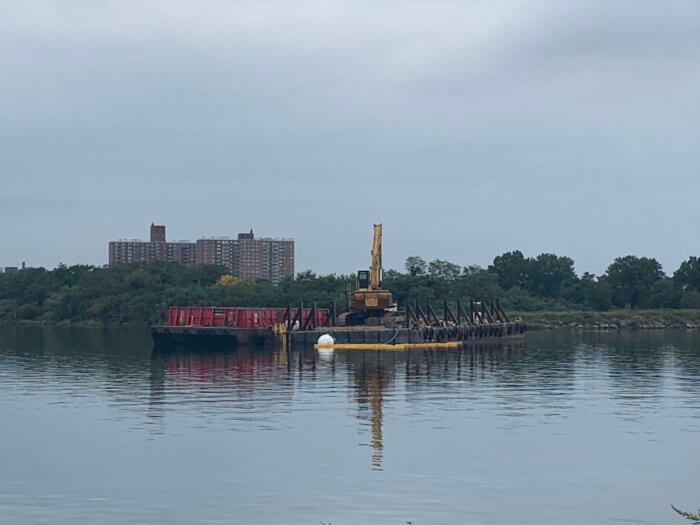
The dozen of speakers at the press conference, including Frontus, spoke of their opposition to a ferry in this location but reiterated they were not against a ferry coming to Coney Island in its entirety but instead should be constructed on the oceanside of the neighborhood.
“I am all for the ferry, I was always been for the ferry, I am not for the ferry here,” said former Community Board 13 chair Joann Weiss. “It belongs on the oceanside, definitely not here.”
“I love the ferry, my grandson and I travel up and down on the ferries. However, I would love the ferry to stop at 16th street where it’s supposed to be, the pier is already done, all you have to do is walk over to everything so why the big hubbub trying to prepare something when you have something already set up for us,” said Sheila Smalls, the tenant leader at O’Dwyer Gardens, adding that the city is going to have to consider the changing tide in their schedule. “I can walk out there on low tide.”
The chair of Community Board 13 said at the press conference that they are inviting the city Economic Development Corporation and the state Department of Environmental Conservation to have a public meeting with the full board on Oct. 27 — and the board announced on Oct. 18 that the agencies agreed to present to the full board on that requested date with updates on the Coney Island Ferry.
“I have directed my district manager as we are speaking to contact EDC and DEC to have a public meeting with us on [Oct. 27],” said Lucy Acevedo at the press conference. “I would guarantee you that I would get a response back saying we are not ready, you have to be ready. I am telling you as chair of Community Board 13, I will continue to harass them to publicly give us the findings of what they found.”
The public is encouraged to contact the state Department of Environmental Conservation Spills Hotline at 1-800-457-7632 to report any suspicious sediment.


